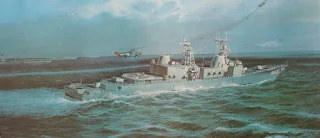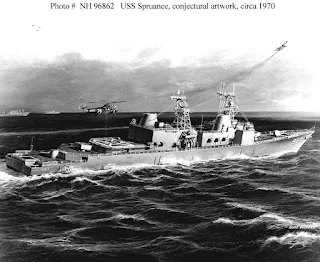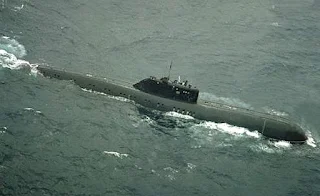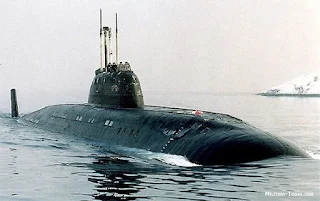As a means of provenance and establishing bona fides the following is a
framed copy of the original conceptual artwork by the Litton AMTD artist Russ
Vickers rendered in 1970. The original was received by the Navy in July 1970. Probably
as part of the massive proposal package delivered at that time. To the best of
the author’s knowledge it has only existed heretofore on the Internet as a
black and white copy available through the United States Navy’s photographic
archives.
In 1970 I was working for Honeywell’s Marine Systems Center
as a staff engineer responsible for maintaining a current threat analysis of
the then Soviet Submarine Force, as well as defining the requirements for
future U.S. Navy anti-submarine weapons systems.
At that point in time the Navy issued an RFP (Request for
Proposal) for a new class of destroyer, whose primary mission would be ASW
(anti-submarine warfare), the DDX.
In anticipation of the RFP Litton Industries had already formed a new
division, AMTD (Advanced Marine Technology Division), initially located in
Culver City, California (metropolitan Los Angeles). The division was subsequently transitioned to the new Ingalls Shipyards at Pascagoula, Mississippi, expressly built by the company to execute the construction of a new class of US Navy destroyer.
Given our established experience in the development and
production in ASW weaponry, reflected, in the ASROC (RUR-5) ASW weapon system,
and the MK 46 acoustic homing torpedo which comprised one of ASROC’s payloads,
Honeywell was signed under contract as a partner to Litton. Our responsibility
was to develop and integrate the total ASW weapon suite for the DDX. An essential element of that suite was the development and production of the US Navy's first digital ASW weapon control system, the ASW Weapon Control System Mk 116 Mod 0.
My responsibilities encompassed working with the U.S. Navy in the
Threat and Mission Analysis which would insure that the totality of the sensor,
fire control, and weapon systems installed in the ship were fully responsive
and effective against the projected Soviet submarines which would be
operational, as well as under development when the DDX was built and deployed at
IOC (Initial Operational Capability). By that point in time in my civilian
engineering capacity I regularly attended briefings and participated in the
development of studies for the then National Security Industrial Association (NSIA; now NDIA-National Defense Industrial Association)
in the field of anti-submarine warfare. At the time of initiating our studies
for the DDX I had recently attended a detailed briefing by U.S. Naval Intelligence
of a brand new second generation of nuclear submarines, the CVY (Charlie,
Victor, Yankee Classes) of SSGN, SSN, and SSBN submarines. All three of these classes incorporated a second generation nuclear plant, and a significantly reduced acoustic signature. It is important to
note that the intelligence had been gained in 1968, and the classified briefing disclosing
it to the civilian ASW community, in either 1969 or early 1970.
As a brief aside, the then President of the NSIA was
Frederick “Fred” Silverthorne, who had retired from the United States Navy as a
Captain, and as a decorated (Distinguished Flying Cross and five Air Medals) Naval Aviator had flown catapult launched Curtiss SOC Seagull floatplanes off the heavy cruiser force during World War II. In a rather
strange and unique set of coincidences, after his stint with NSIA, Fred was
elected to the position of Mayor of Fairfax, VA, and subsequently retired with
his wife Bette to Sun Lakes, Arizona, becoming almost our next-door neighbors. Fred and I became very close friends for the
remainder of his life.
 |
| A Curtiss SOC floatplane being recovered and repositioned on the port catapult of the USS Minneapolis (CA-36) on 5 October 1943 following a bombardment of Wake Island |
 |
| Two Curtiss SOC-1 floatplanes positioned on the catapults of the Omaha Class light cruiser USS Cincinnati (CL-6) |
In a parallel career I had been fortunate enough to have
been promoted to Commander in the U.S. Naval Intelligence Reserve Program. My
two weeks active duty each year had afforded tours of duty with major fleet/shore
commands including, COM3rdFLT, COM1stFLT, COMNAVAIRPAC, Naval Intelligence Command (NIC) Headquarters, NFOIO (Naval Fleet Operational Intelligence Office), and CNO
Intelligence Plot, working specifically in the field of ASW. The combination of
these two avenues of access afforded me a reasonable knowledge of the Navy’s
established intelligence on both the current and future Soviet Submarine Force, and its operations.
I had been fully aware of the emergence of the Soviet CVY Group since shortly
after the development of the initial intelligence. “Need-to-know” limitations
had precluded my use of this knowledge in my civilian position until the NSIA
briefing. The following photographs in sequence are the Charlie I Class SSGN, the Victor Class SSN, and the Yankee Class SSBN. The viewer can discern the bulbous shape of the Charlie I bow, as well as the large hatches over the vertical tubes (not horizontal) housing the SS-N-7 missiles.
As an integral and essential element of the RFP for the DDX, the Navy’s Ship Systems Command Program Office developed a series of threat scenarios which defined the operational requirements to which the ship and its combat system were to be able to effectively respond. You can perhaps appreciate my shock and disbelief when we received copies of the DDX RFP, and the accompanying SECRET/NO FOREIGN annex which incorporated the detailed threat scenarios. As the projected threat to the DDX (IOC 1975) they had defined the then decade old November Class SSN (IOC 1958) firing torpedoes. These at that time included the Type 53 and 53-56 series, 53-65K (wake-homing), the ET-80, the early ET-60 series, and a torpedo with a nuclear warhead option, with launch ranges between 20 and 24 kyds (exception nuclear warhead), at speeds between 44 and 45 kn. The November Class boats were capable of a very respectable submerged speed of 30 kn.
 |
| The Soviet Navy 53-65K wake homing torpedo (IOC 1965) |
The following photograph purports to be of the Soviet T-5 nuclear torpedo. It is from open sources. Given the inherent secrecy of Soviet weapons programs, let alone nuclear weapons, combined with the translation of the Russian language to English, the photo and weapon's characteristics, even though dated from the mid 1950's, should be considered provisional.
T-5 Torpedo
IOC: 1958 (only remained in operational inventory for 2 years, but not known at the time)
Diameter: 553 mm (21 in.)
Length: 792 cm (25.98 ft)
Propulsion: Electric/Combined cycle
Range: 10 km (5.4 nm)
Speed: 40 knots
Warhead: Nuclear (nominal 3 kt yield)
 |
| The Soviet Navy T-5 nuclear torpedo (IOC 1958) |
The new Charlie Class SSGN had been established as capable of submerged launch of up to eight SS-N-7 Starbright (Soviet designation; P-70 Ametist/4K66) cruise missiles with an operational range of 35 Naut. Mi. at Mach 0.9. The warhead being either 1,170 lbs of high explosive or a nominal 200 kt nuclear yield. For comparison the Hiroshima nuclear weapon had a yield of approximately 15 kt. The submerged speed of the submarine was 24 kn. To put this into stark perspective the Navy’s Program Office had stipulated as the projected threat baseline a submarine that was already a decade old, and torpedoes not missiles, for a new class of destroyer with a projected IOC of 1975, almost two decades differential. This directly in the face of verified intelligence that an entire new second generation of Soviet submarines (with submerged cruise missile delivery capability) was at that very time being deployed in series production.
 |
| The SS-N-7 Starbright (P-70 Ametist/4K66) cruise missile |
Litton was successful in winning the contract for the DDX, which now became known as the DD-963 Spruance Class destroyer, named after ADM Raymond A. Spruance who commanded U.S. naval forces during two of the most significant naval battles of WWII that took place in the Pacific theater, the Battle of Midway and the Battle of the Philippine Sea .
In one
of the first design reviews scheduled by the then Navy’s Ships Systems Command
(then NAVSHIPS, now Naval Seas System Command – NAVSEA) Program Office for the
DD-963 I had the opportunity to review my work to that point with two LCDRs (Lieut-Commanders)
from that office. Their names will remain anonymous. I expressed my grave
concerns regarding the fact that in 4 out 5 (or 6, unfortunate lapse of
memory) of the detailed threat scenarios provided, that the November Class SSN
was able to achieve effective launch range of the stipulated operational Soviet
submarine torpedoes, prior to effective own ship reaction/response time, i.e.,
detection, classification, target designation, target motion analysis,
launcher/weapon orders, weapon launch, flight time, deployment, target acquisition and homing. This was quantified by physics and mathematics,
no latitude for conjecture or doubt. One of the detailed analyses which we
developed, required as a deliverable under contract, was a series of OSDs
(Operational Sequence Diagrams) which defined in excruciating detail, own ship, quantified, sequential
response through the total threat engagement in each threat scenario. I was personally intimately familiar with these OSDs, I had developed each one.
At
that juncture, I exacerbated their dilemma by asking them about how they
planned on dealing with the Charlie Class SSG(N)/SS-N-7 challenge? Response; momentary shock and disbelief, then, and I will never forget it, HOW DO YOU KNOW ABOUT THAT!? Not even
needing to rely on my naval intelligence background, I related that facts had
been conveyed to the civilian ASW community in the NSIA briefings. Needless to
say, two very chagrined LCDRs. Honestly I cannot recall how they reconciled the
situation, in as much as I was as shocked and angry as they were. At that point
in the program they would have had access to the basic intelligence, probably
at a level of knowledge between what I then knew as an intelligence officer, and as a weapon systems engineer. I’m not certain what guidance they were ultimately
able to obtain, nor at that level how prescient either officer was, but I’m
certain all of us agreed the Navy needed a new class of destroyer.
As the
program progressed I became more and more frustrated with the fact that while as
a basic weapons system platform the DD-963 was projected to be potentially a highly capable
and versatile hull, its capability as an effectively armed
combatant was in its initially specified configuration severely lacking.
Independent of either my position at Honeywell or as a naval intelligence officer, I drafted an article, entirely from unclassified open sources, comparing the projected Spruance Class destroyer to the then operationally deployed Soviet Navy Kynda (Project 58 - Ракетные крейсера проекта 58) Class and Kresta I (Project 1134 Berkut) Class guided missile cruisers. In essence the article conveyed that at both significantly lesser, as well as comparable displacements, the Kynda and Kresta I Classes, already at sea, were ton-for-ton (kilogram-for-kilogram) far more formidable warships.
Kynda Class
Commissioned 1962
Displacement: 4,000 tons standard, 5,000 tons full load
Length overall: 466 ft
Speed: 34 knots
Kresta I Class
Commissioned 1967
Displacement: 6,000 tons standard, 7,500 tons full load
Length overall: 521 ft 8 in
Speed: 34 knots
Spruance Class
Commissioned 1975
Displacement: 8,040 (long) tons
Length overall: 563 ft
Speed: 32.5 knots
The following series of photographs and outboard profiles of the three ships will afford the viewer the opportunity to make that same comparison.
I submitted the article (including a comparative drawing of the ships) to the US Naval Institute Proceedings for potential publication, with a copy to Honeywell management. It suffices that the reaction time of Honeywell was by far swifter, and more directed, than the Spruance could have ever mounted against a Soviet submarine. I was told, in no uncertain terms, that if I was to enjoy continuing employment, I should retract the article. Unfortunately, at that juncture a wife and three small children weighed heavily in the decision, and the article was withdrawn. What was to prove particularly bitter and galling was that within no more than a couple of months the Naval Institute published an article, authored by two active duty navy captains (possibly a career limiting action), which detailed the exact same sentiments. At least it got said. Once again another Don Quixote windmill. Fortuitously, albeit over an un-necessarily protracted period of time, with the integration of the Vertical Launch System, VLS Mk 41, the Spruance Class became a much more capable warship. See previous article; http://arnhemjim.blogspot.com/2013/04/one-of-don-quixotes-broken-lances_19.html





















